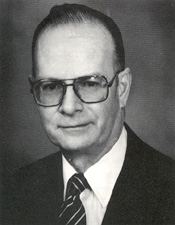Ford's administration was short-lived. He resigned in the summer of 1983 to return to California as president of a large savings and loan association. On November 21, Robert Forrestal was named president of the Bank.
 In 1983 Robert P. Forrestal assumed the presidency of the Federal Reserve Bank of Atlanta. |
Forrestal had been at the Bank 14 years and had served the System for 19 years—since he joined the Board of Governors' legal staff in 1964. Of the Bank's 12 chief executives, Forrestal was the fourth attorney, and the third to follow the path from general counsel to first vice president and then to president.
Like Bryan, Kimbrel, and Ford before him, Forrestal has spoken out against inflation, but he also has directed his leadership to new areas. The high inflation of the early eighties had begun to abate by the time he took office, but a host of pressing issues—including the appreciation of the dollar on foreign exchange markets, a stubborn debt crisis in the third world, and changes in the U.S. financial system that complicated the process of setting monetary policy—competed for attention.
To Forrestal, these conditions called for systematic study, and he quickly moved to transform the research department into an organization that could provide the caliber of economic analysis needed to support monetary policy-making. For many years, the research department had struggled with limited resources and one of the smallest staffs in the System. Ford added resources, but he took a very different tack by turning attention away from those subjects traditionally studied by Atlanta Fed economists—agriculture, banking, and regional business conditions—to "popular" topics that would appeal not only to a broad business audience but also to the economically curious person on the street. Articles published in the Bank's Economic Review tended to deal with such aspects of business management as automation and profitability and with individual industries rather than monetary and regulatory policy. Highly visible conferences at which prominent speakers discussed currently fashionable topics like supply-side economics also reflected Ford's interests.
Some hailed the change as a refreshing departure from the more traditional approach usually taken by Fed researchers. Others, including the Federal Reserve Board in Washington, thought it an inappropriate divergence from a public policy focus, thereby diminishing the role of the Atlanta Bank's research department in laying the groundwork for monetary and regulatory policy.
To redirect Atlanta's research staff, Forrestal brought in Yale-trained economist Sheila Tschinkel, who had earned respect within the System with her work at the New York Fed's trading desk. In addition to reviving the Bank's traditional interests in the region's agriculture, industry, and banking, Tschinkel bolstered macroeconomic research, particularly in international issues. She brought in economists who expanded the department's focus to the entire financial system, including the inner workings of financial markets and product innovations like interest-rate swaps. Within five years, Atlanta's research department began to earn the clear approval of the Board as well as growing respect among other Reserve Banks and academic economists.
Forrestal's choice of Tschinkel signaled more than a new direction in research. It advanced the new president's goal of bringing more women and minorities into positions of leadership in the Bank. He also has taken a strong interest in international banking and monetary issues as well as foreign trade and investment. He speaks often on these subjects, advocating southeastern recognition of the globalization of world markets and encouraging foreigners to become familiar with this region of the country.
The growth of international banking, along with the burgeoning interstate banking movement, has accelerated the expansion of the Bank's supervision and regulation division. "SuperReg," after its tentative start in the pre-Depression years, already had grown into a major activity of the Bank after the Fed was designated the regulator of bank holding companies in 1956. As new bank regulations flowed regularly from Congress in the 1960s and 1970s, the work load for the bank examiners mounted. In addition, soaring interest rates and the deepest recession since the 1930s had rocked the banking industry in the early 198Os, leading to post-Depression highs in bank failures. Together, these developments required a staff that grew from 30 examiners in 1969 to 61 in 1979 and 103 in 1989. The supervision and regulation division has broadened its scope as well in recent years, sending officers to participate in examinations in other countries.
Forrestal moved to keep the Bank's momentum in operations by choosing as his first vice president Jack Guynn, who had been a leader of the team that had developed the Bank's highly automated approach to operations. Guynn has helped to extend the Bank's leadership beyond Sixth District boundaries. The System's electronic funds transfer (EFT) office was assigned to the Atlanta Bank in 1988, with Guynn as product director and Richard Oliver as product manager for System EFT. Elsewhere in the Bank, Fred Herr, manager of the Birmingham branch, was named chairman of the System subcommittee on the payments mechanism.
"Over the last five years, the Atlanta Bank has provided extraordinary leadership to the System," says Chairman Bradley Currey, Jr. In many ways, the Bank's emergence as a System leader is a culmination. Currey himself is the son and namesake of the man who opened and managed the Bank's Nashville branch in 1919, when Max Wellborn was Governor. "This Bank is full of good people," he says with pride in the competence, efficiency, and progressive management he sees in today's Atlanta Fed. But recalling his own father, he makes it clear that good people also went before them.
| Previous | Next |



